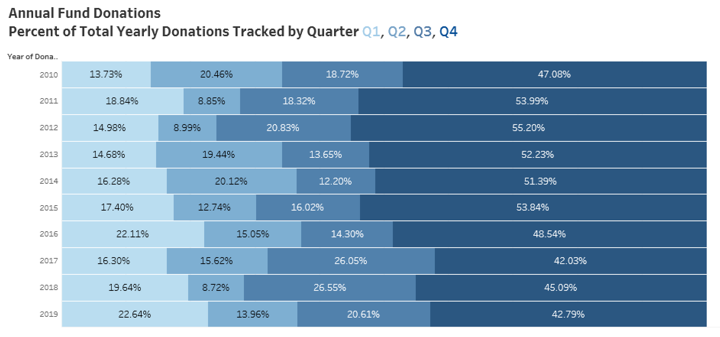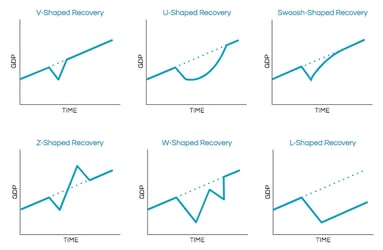Recently, Windfall was a proud sponsor of and participant in Seminar 2020, the annual gathering of fundraisers from fraternal organizations hosted by the Foundation for Fraternal Excellence (FFE).
A common theme running throughout the event was how organizations can successfully navigate change. In his keynote address, speaker Greg Offner shared how individuals can overcome ‘disruption-causing events’ to become agents of disruption themselves. To achieve ‘disruption’, which he reframed as “change that sustains and sets a new standard,” Offner recommended, among other things, taking an incremental approach to achieving larger goals. Likewise, in his closing keynote, York College professor Jason Lewis suggested the key to change is adopting the role of the ‘explorer,’ who is “always learning, gathering information all the time, and aiming for very meaningful and significant decisions.”
In Windfall’s session at FFE, we were fortunate to be able to showcase an example of how these approaches to positive disruption are put into action in real life. Hosted by Windfall VP of Customer Success, Mike Vincent, and featuring Alpha Tau Omega (ATO) Director of Research, Chris Smith, this ‘wireside chat’ explored how one organization embarked on their journey to become data-driven. While the journey was long (spanning approximately two years), they would eventually prove the value of their efforts with measurable outcomes, including a doubling of their kickoff appeal for 2020!
In his approach to transforming ATO Foundation’s fundraising to be more data-driven, Chris put ATO on a purposeful and methodical path:
- Audit Your Data
- Employ Data Best Practices
- Establish a Baseline
- Generate Intelligence
- Put the data into Action
- Measure & Iterate
Step 1: Audit Your Data
The initial challenge that often prevents organizations from starting on their data journey is taking stock of their data. As we’ve seen with many organizations, it may be a technical barrier, such as the ability to link multiple sources of constituent data. But it can also be a daunting task to make a thorough and honest assessment of one’s data and expose the gaps that have developed over the years.
But that’s exactly where Chris started his journey — with a deep dive of his fundraising database. In doing so, he quickly realized that he was faced with a “bottleneck of accurate information”:
- While giving history was usually tracked, it wasn’t always consistent.
- When donations were tracked, there was valuable information missing, such as the appeal associated with the donation.
Chris knew that to generate meaningful and actionable insights, he would have to start building a more reliable foundation of data.
Step 2: Employ Data Best Practices
As with other professionals, the best fundraisers are constantly seeking ways to improve their processes (It's for this reason that data best practices are central to the Windfall Customer Success program). To establish a trustworthy foundation of data for ATO, Chris gleaned insights from other organizations as to the best practices his organization should be following:
- He implemented protocols for effectively capturing a greater amount of detail during the fundraising process.
- He ensured all members of the team were aligned on the value of these new processes. Bad Data In = Bad Data Out.
By establishing these processes and getting buy-in across the organization, ATO would start to develop a more complete and trustworthy dataset for future analysis.
Step 3: Establish a Baseline
Chris also started to analyze the data he did have available to him — past contributions. By uniformly looking at when contributions arrived and were entered into the system, he was able to gain visibility into how the organization’s fundraising performed historically across years and quarters.
For instance, he now saw that over 40% of annual donations typically arrive in the last three months of the year. With that in mind, he now knew that if ATO hadn’t achieved 60% of its goal by October 1st, they’d have a heavy lift in store for the remainder of the year. More importantly, through his analysis, Chris was able to establish a baseline against which to compare future performance.

Step 4: Generating Intelligence:
After a year of consistent tracking of data, Chris was ready to take ATO on the next step in its journey to becoming data-driven. He turned to Windfall’s Wealth Screening solution to develop a more complete profile of his constituents with net worth and other attributes. Leveraging his mathematical background, Chris married Windfall’s third-party data with ATO’s first-party data to develop multiple propensity models to score potential donors.
Both ATO attributes and the net worth and attributes provided by Windfall have proven to be key indicators of giving in Chris’ models — some demonstrating a positive correlation and others a negative correlation. While we have masked the attributes in the table below for confidentiality, we can’t help but share one insight — the top predictors from Windfall were philanthropic giving and multiple property ownership, two of the attributes we provide for the over 82M US households Windfall tracks.
“Knowing someone’s wealth capacity is invaluable and Windfall setting the metric at households likely to have a million dollar plus is at the heart of my propensity score…”
NOTE: For those organizations that don’t have the internal tools or resources to develop their own propensity models or that want to quickly incorporate the power of machine learning into their efforts, Windfall also provides custom propensity models. Marrying an organization’s first-party data with Windfall’s precise wealth intelligence, the models are bespoke to identify constituents most likely to give at an established goal.
Step 5: Making the Data Actionable
To start to put his new-found insights into action, Chris created additional propensity scores based on specific contribution amounts, and incorporated them into two plans:
- Score previously solicited prospects that hadn’t given and shift them from assigned development officers to annual fund solicitations.
- Replace those prospects with new, higher-scoring prospects, which the team would commit to prospecting for the year.
Step 6: Measuring & Iterate
With the data put into action and a baseline established, Chris has started to gauge how ATO Foundations appeals are performing against previous years. In fact, their kickoff appeal for 2020 has already doubled that of the previous year!
What Chris also recognized is that being data-driven is an ongoing process of continuous improvement. To that end, he’s leveraged the insights he’s able to generate to inform future fundraising plans. For instance, based on the data, ATO has begun adjusting messaging and testing the length and frequency of appeals.
This iterative process is something we employ at Windfall in the development of our own data and one that we encourage our customers to take. In our most recent post, You can learn how other forward-thinking nonprofits like NYU have successfully incorporated this approach into their own development frameworks.
Conclusion
In the words of FFE’s keynote speaker Greg Offner, Chris Smith and the ATO Foundation were able to disrupt and affect “change that sustains and sets a new standard” in the way they employed data in their fundraising efforts. They also demonstrated that this type of disruption does not usually happen overnight, but incrementally, by applying a methodical approach as laid out above. Regardless of where your organization is in its use of data, the most important takeaway is to get started.
At the end of the session, Chris provides three areas where organizations can get started on their path to becoming data-driven:
- Audit your data and establish a baseline — Understand what you know and what you don’t know. Identify the gaps and also the bright spots in your data.
- Get internal alignment — Ensure your organization is aligned on what you do and why you do it and use a common language.
- Test everything — A/B test everything. Anything you learn will help to improve the impact of all your future activities.
This article was authored by Patrick Cava, VP of Marketing and Mike Vincent, VP of Customer Success, based on Windfall’s FFE Seminar session featuring Chris Smith, Director of Research at ATO Foundation
About Windfall:
Windfall helps you identify, understand, and engage the affluent. We provide you with precise net worth data on affluent US households, allowing you to make informed data-driven decisions.
For more information about Windfall please visit our website: www.windfall.com.






